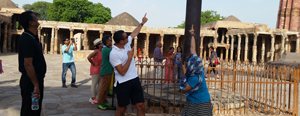
Kryton’s Rolf Skala and Kryton India’s Anandita Kakkar stand along side the Iron Pillar of Delhi – a symbol of strength that has lasted for over two thousand years.

This photo shows extensive corrosion on an off-ramp from a cities well used bridge. It is notable that the corrosion on the reinforcement is alighted with the cracks in sections that have not spalled (yet). This clearly illustrates that the cracks have provided the path for water and salts to reach the reinforcement and initiate corrosion.
In 402 CE, a monarch in what is now Udayagiri, India, erected a symbol of strength now known as “The Iron Pillar of Delhi”. The ancient Indian blacksmiths demonstrated their skill and precision in the creation of this pillar. It has stood the test of time with resiliency to the effects of the local Delhi climate (where it now stands).
We battle daily with the fact that deterioration is a part of life. Deterioration is as natural as time, and prevention can be as elusive as the perfect anti-aging elixir. We cannot stop time, we can only mitigate exposure to elements that “quicken the pace” of deterioration.
Insofar as mitigating the deterioration of a structure, well, this begins with the use of quality products and materials. The materials must also be protected to preserve longevity and effectiveness to ensure a durable structure is built. If the iron and steel used to reinforce modern concrete buildings were as corrosion-resistant as the Iron Pillar of Delhi, we would not need to focus as much attention as we do on protecting the skeletal systems of our structures. However, it is not feasible to spend the amount of time and resources required to create metal compositions with such unique properties, and thus we must protect our structures by way of mitigating the penetration of corrosive entities.
The penetration of water into concrete is a critical factor in the corrosion of reinforcing metals. Water acts as a carrier for chloride ions, which is also required for corrosion to occur. Therefore, the first line of defense against corrosion is to prevent the penetration of water into the concrete. Read more about Kryton’s permanent waterproofing solution for concrete structures here.
When structures last longer than expected, they carry with them the stories of the past – encapsulating historic moments, and becoming a testament of durability: durability of the structure itself, but moreover, the durability of a way of life. The inscription carried by the Iron Pillar of Delhi, as well as the marks of wear that it bears like medals of honour, tell stories of the rich, strong Indian history the monument has not only witnessed, but also been a part of. Whilst building the modern, iconic structures of the present day, we must take note of how the structure will be perceived in years to come, and plan for our own monuments to be durable enough to carry our own stories through to future generations.



